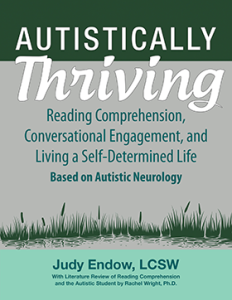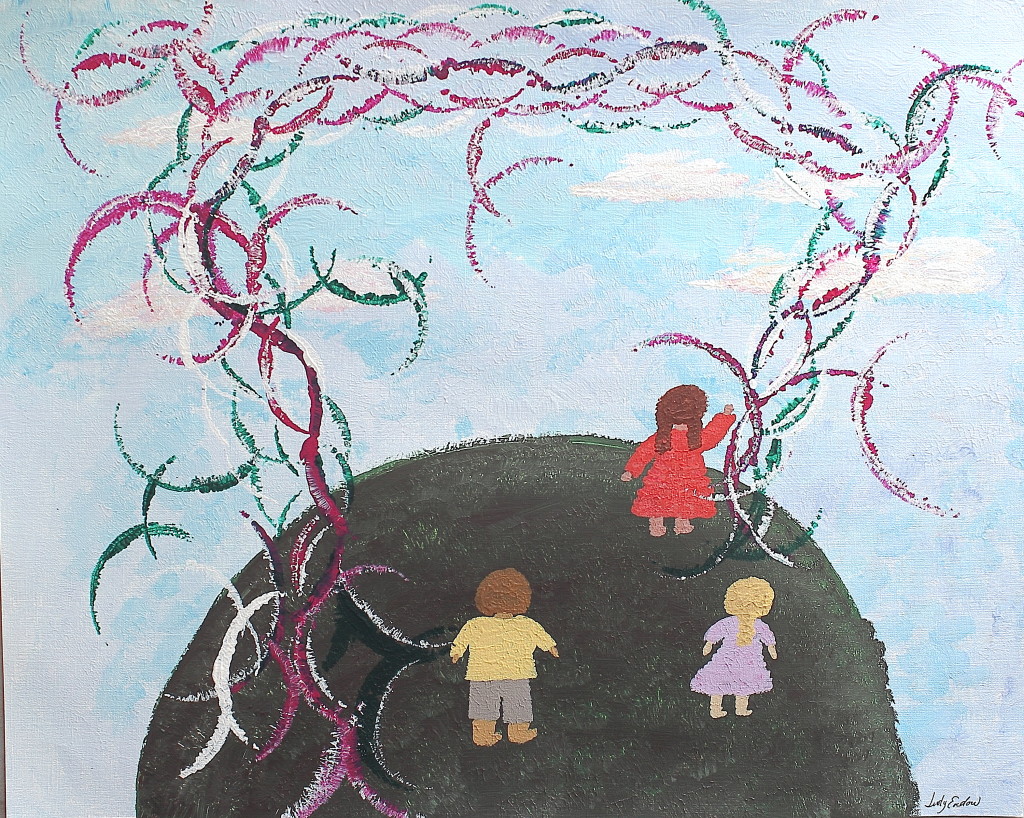Finally, after almost two years since it’s beginning, my newest book is in the printing process! A lot (besides working as usual) has happened during these two years – David (my oldest) and Heather welcomed Niko into the world (my first grandchild), Paul (middle child) and Laura moved across the country, and Daniel (youngest child) finished grad school. Also, during this time I went to Hawaii and a few months later had an unexpected surgery with a three month recovery. Entwined into all of life was the labor of this book!

Autistically Thriving
Reading Comprehension, Conversational Engagement,
and Living a Self-Determined Life
Based on Autistic Neurology
During this book writing process I’ve hardly written a blog at all. I hope to get back to blog writing in the near future. For now I will hopefully entice you with the Introduction of this new book:
AUTISTICALLY THRIVING INTRODUCTION
Most anything about autism and learning typically start out with the deficits of autism responsible for the problem experienced by the autistic. Then, it is followed up with ideas on how to address the deficits so as to impact the problem. If I were to start this book that way I would next talk about the diagnostic criteria. Here is what the DSM-5 says:
ASD Diagnostic Criteria
Persistent deficits in social communication and social interaction across multiple contexts (current or history)
1. Deficits in social-emotional reciprocity…
2. Deficits in nonverbal communicative behaviors…
3. Deficits in developing, maintaining and understanding relationhips…
Restricted, repetitive patterns of behavior, interests or activities…motor movement, sensory, sameness, routine, fixated interests in objects or topics
– Diagnostic and Statistical Manual of Mental Disorders, 5thed., 2013
In case you don’t know how the DSM diagnosing works I can fill you in. We have our normal everyday people on the face of the earth. They make up most of the population. Because this group makes up the majority we have decided their behaviors are typical and we label them normal. Then, everyone else is measured according to how far away from normal they land. And if they land far enough away from normal in enough areas they get a diagnostic label.
By design, DSM labels are framed in deficit terms. And in terms of diagnostics this deficit language is helpful. However, it isn’t very often helpful when we take this deficit-based language out of the diagnostic arena and use it to describe who and what autistic people are in this world.
We are ever so much more than the sum total of our diagnostic deficits. So, let’s begin with autistic people – who are they? how do they think? what are their strengths? their skills? their way of understanding the world? How do they understand other people?
All of my life, until very recently, I have only known what I am not. It is because autism is largely measured by absence of neurotypicality. My hope for the future is that autistics coming up behind me will grow up with a more positive sense of self – learning who they are in this world rather than who they are not.
In that spirit I write from a perspective shift. A self-determined life is empowered through comprehension of the context in which we live. Let’s start with autistic people and comprehension – reading comprehension and life comprehension. How does it work? How do we empower autistics, based on their neurology, to comprehend what they read and to better understand the foreign land in which they find themselves living? (Endow, 2019, pp. xiii-xv)
AUTISTICALLY THRIVING BACK COVER TESTIMONIALS
Autistically Thriving is a groundbreaking book that shows people on the spectrum how to leverage the natural strengths of their neurology to navigate the world effectively and live up to their fullest potential. Wise, compassionate, engagingly written, and deeply knowing about the distinctive cognitive styles of autistic minds, Endow’s book makes the lessons of the author’s bold, creatively atypical life available to the next generation of neurodivergent innovators.
– Steve Silberman, Author ofNeuroTribes: The Legacy of Autism and the Future of Neurodiversity
*****
Judy Endow has been my best teacher and friend for several years. My education continues with her book Autistically Thriving. This groundbreaking book helps everyone understand the autistic neurology. This is the first step in supporting autistic people to excel. If you read one book on ASD this year, this should be it!
– Brenda Smith Myles, PhD, Speaker and Author, Excelling With autism: Obtaining Critical Mass Using Deliberate Practice
*****
Judy Endow has again created another thought-provoking yet practical resource for supporting those on the autism spectrum. It is not only filled with deep insights and rich examples, but it is honestly one of the best books I have ever read on how to support students who have unique ways of engaging in lessons, understanding material, and interacting with others.
Judy Endow simply sees things that others miss. Drawing on her experiences as a social worker, education consultant, and individual with autism, she provides the “why” of learning challenges along with the “how” of responding to them. This is, of course, a book about teaching and you will learn a lot about literacy instruction, social needs, and advocacy, but Autistically Thriving will also inspire you to think differently and truly appreciate the uniqueness and beauty neurodiverse learners bring to a classroom.
– Paula Kluth, Ph.D., Author of You’re Going to Love This Kid: Teaching Students with Autism in the Inclusive Classroom
*****
The book is one of the best books on autism where information and art meet to include each other from the beginning until the end. The layout of chapters, subheadings and vivid explanations can captivate the attention of any one who wants information about an autistic person’s sensory struggles, coping mechanisms of the mind and growing a philosophy out of odds. I would recommend this book to parents and providers who want to involve themselves in the life of an autistic person.
– Tito Rajarshi Mukhopadhyay, Author of How Can I Talk if my Lips Don’t Move and Plankton Dreams – What I learned in Special Ed
*****
In Autistically ThrivingJudy Endow acts as a translator. She takes the autistic experience and puts it into words. These are the words that most of us in the neuromajority need to more fully comprehend the neurological processing of autistic people. This comprehension will lead the way to a future full of more respectful, collaborative, and effective support systems for autistics. These systems, in turn, will allow more people with autism not to just “get by”, but to truly THRIVE.
– Sharon Hammer, LPC, Co-Author of Lights, Camera, Autism Series
BOOKS BY JUDY ENDOW
Endow, J. (2019). Autistically Thriving: Reading Comprehension, Conversational Engagement, and Living a Self-Determined Life Based on Autistic Neurology. Lancaster, PA: Judy Endow.
Endow, J. (2012). Learning the Hidden Curriculum: The Odyssey of One Autistic Adult. Shawnee Mission, KS: AAPC Publishing.
Endow, J. (2006). Making Lemonade: Hints for Autism’s Helpers. Cambridge, WI: CBR Press.
Endow, J. (2013). Painted Words: Aspects of Autism Translated. Cambridge, WI: CBR Press.
Endow, J. (2009). Paper Words: Discovering and Living With My Autism. Shawnee Mission, KS: AAPC Publishing.
Endow, J. (2009). Outsmarting Explosive Behavior: A Visual System of Support and Intervention for Individuals With Autism Spectrum Disorders. Shawnee Mission, KS: AAPC Publishing.
Endow, J. (2010). Practical Solutions for Stabilizing Students With Classic Autism to Be Ready to Learn: Getting to Go. Shawnee Mission, KS: AAPC Publishing.
Myles, B. S., Endow, J., & Mayfield, M. (2013). The Hidden Curriculum of Getting and Keeping a Job: Navigating the Social Landscape of Employment. Shawnee Mission, KS: AAPC Publishing.














